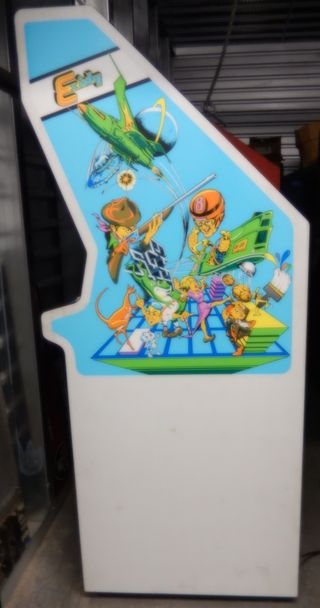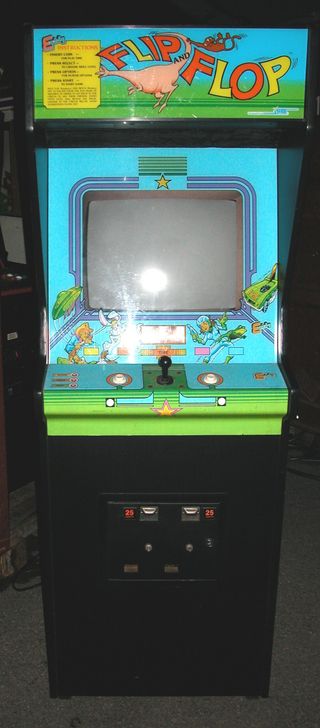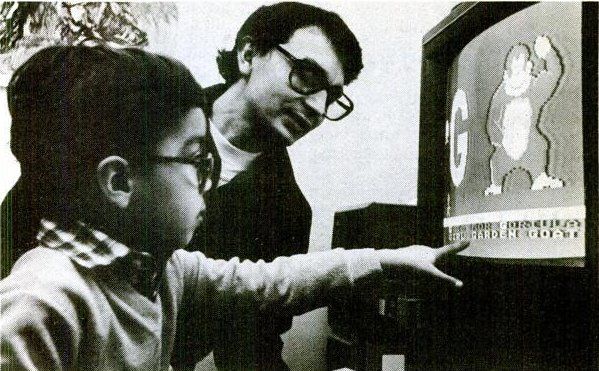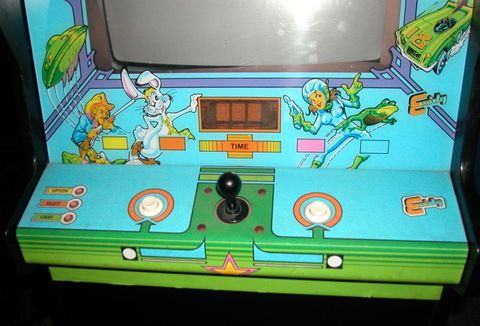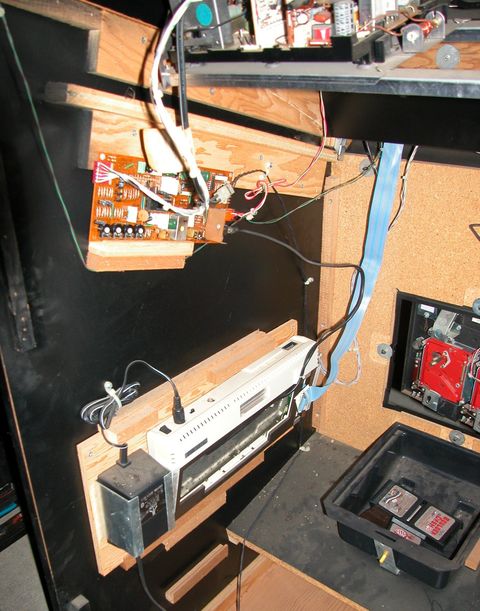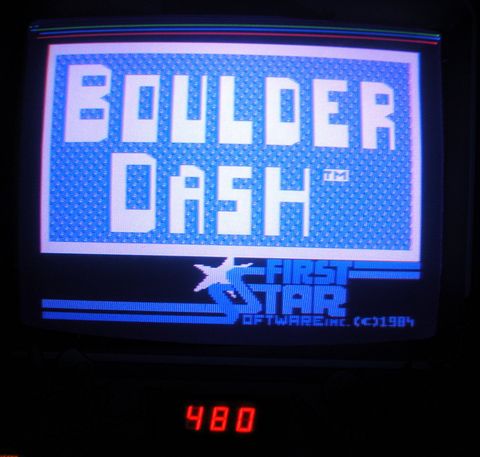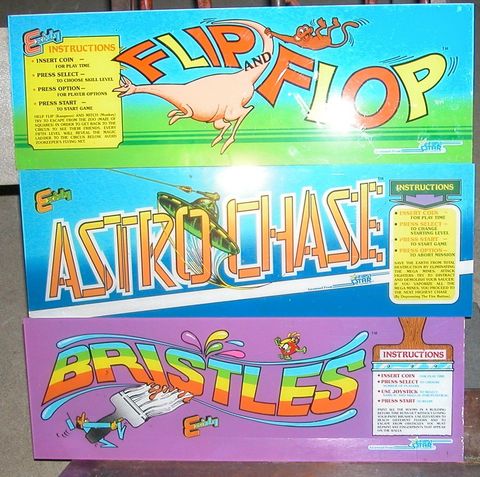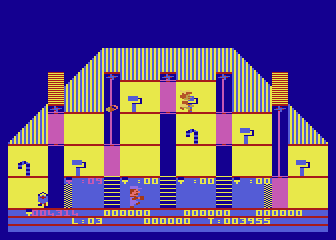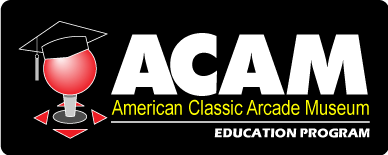Game History
Exidy Max-A-Flex System
Publisher/Manufacturer: ExidyDeveloper: First Star SoftwareRelease Year: 1984
By Mike Stulir • Vice President, The American Classic Arcade Museum
Usually when I write articles or ACAM & our education program, I write about titles that we have in the museum. On occasion, though, I think it is fun to look at some unique games that we do not have in our collection... games that are super rare, or perhaps just became lost with the passage of time. With that in mind, let's have a look at the Exidy Max-A-Flex
system... an arcade game cabinet based around an Atari 600XL computer.
The Max-A-Flex
game cabinet was very unique in its time. The cabinet featured a 19 inch color monitor, generic bezel/side art, a single joystick with a single fire button, and at its core, an Atari 600XL computer. It was designed to be easily converted to other games once the popularity of an existing title wore out. Unlike other game conversion methods of the era, converting Max-A-Flex
only involved swapping out a game cartridge and switching the marquee. Literally, a 10 minute job to update the cabinet to a fresh game. Exidy sold the cabinet to arcade operators for around $1,900. The cabinet came with four titles; Boulder Dash, Astro Chase, Flip & Flop and Bristles. Future games were promised that would sell for around $100.
Max-A-Flex games came on a cartridge that was completely unmodified from the cartridges sold to the consumer for use on Atari computers at home. The cabinet had a timer board with a countdown display that was placed behind the monitor bezel & hacked into the computer via a ribbon cable. The playtime per game credit was determined via dip switch settings on the timer controller board. While the game is active, the timer counts down & all controls are functional. Game options can be chosen via the Start/Select/Option buttons on the left side of the panel. The game controls for the cabinet consisted of a standard 8-way arcade stick and a single action button. When the timer gets down to 10 seconds of remaining time, the cabinet will emit progressively higher audio tones to signal that you need to insert more coins. If the timer gets to zero, the controls go dead but the game does not reset. You could insert another coin to continue, or let your lives run out so another player could start fresh. It was an odd situation when compared to other arcade games. You could still have several lives left in reserve, but once time ran out, the game was over unless you inserted more money.
While the lack of change to the games for use in an arcade environment certainly seemed odd, the flip side of this is that since the games were completely unmodified, there was nothing stopping the clever operator from inserting any old Atari 8-bit cartridges into the cabinet. If the cart was compatible with the 600XL, it should work. You could not “officially” buy non-licensed cartridges for use in an arcade cabinet, but there was no mechanism stopping you from doing so.
The choice of a 600XL computer is interesting. Inside of the game cabinet is an arcade monitor with a converter board to accept composite video. However, the 600XL did not have the composite output of its bigger brother, the 800XL. I would have to assume that the 600XL was chosen as it was $100 less expensive than the 800XL. In order to make that computer work with composite video, a significant amount of hacking was performed on the computer.
So how did the Atari 600XL computer end up being the central nervous system of an arcade cabinet?
The story starts with a programmer of those computers named Fernando Herrera. Herrera, a native of Bogota, Columbia, left his career as an architect & industrial designer and immigrated the United States in 1970. Working in New York as a computer store manager, he became a self-taught programmer.
Herrera had a son named Steve with serious eye problems. Those problems were so severe that the medical experts predicted that there would be no way to overcome them and he would be blind for the rest of his life. Herrera, not taking this news lying down, decided to create a computer program with large visual cues that would help his son learn the alphabet. After many months of use, this program helped Steve make great strides in overcoming his handicap. Herrera sent this software to Atari for publication consideration in the Atari Program Exchange (APX) catalog, which was a mail order software store Atari operated to help publish home-developed programs. Fernando’s program was named My First Alphabet, and went on to become the first annual APX “Atari Star” award winner. The annual “Atari Star” award was the grand prize for the best program submitted to APX. The award also included a trophy and a $25,000 cash prize.
Fernando Herrera (r) and his son Steve play My First Alphabet.
Fernando used his prize to team up with film producers Bill Blake & Richard Spitalny to found First Star Software in early 1982. By the end of 1983, game titles like Astro Chase, Flip & Flop, Omnicron Conspiracy & Boulder Dash had the company well on its way to being a top tier publisher of computer games. Then, Atari’s parent company, Warner Communications, acquired a 50% ownership in First Star Software.
At the same time, coin-op game developer Exidy was looking to do something innovative and inexpensive with arcade games. A company known for such arcade games as Crossbow, Venture, Star Fire, Mouse Trap & Circus, Exidy was looking for a way to be cost-competitive with larger coin-op game developers like Atari, Namco & Williams by eliminating costly development & research expenses. Bundling existing technology into an arcade cabinet would be a good way to eliminate those costs. Exidy kept this project a secret. Company founder Pete Kauffman and a very select few of Exidy’s engineers were aware of the project until it was publicly revealed.
Countdown timer board mounted behind the Exidy Max-A-Flex monitor bezel. Photo by Bill Esquivel.
Exidy entered a licensing agreement with Warner/First Star to acquire four of their games for use in the Max-A-Flex system. The story starts to get a bit sketchy here with the details of the agreement. ACAM’s research has revealed varying numbers of the amount of Max-A-Flex cabinets they needed to sell over the course of one year license to fulfill the agreements. Available information shows anywhere from 1,000 to 2,000 units needed to be sold. ACAM’s initial estimate of cabinets produced & sold to operators were in the 750-1,000 unit range. However, recent evidence has shown that number to be less than 400 cabinets… and probably much lower than that.
Interior of an Exidy Max-A-Flex cabinet with the Atari 600XL computer and video converter board. Game cartridges can be seen in the coin box. Photo by Bill Esquivel.
When Exidy could not fulfill their license terms, First Star terminated the agreement, and Max-A-Flex faded into obscurity.
Arcade game collector Bill Esquivel provided the cabinet photos in this article. He has owned a number of the Max-A-Flex cabinets over the years. His most recent acquisition of a Max-A-Flex cabinet was in September of 2015 from former Exidy employee Ken Nicholson via a Craigslist ad. When Bill picked up the game, Ken confirmed that only a few hundred of these cabinets were produced. Ken stated that near the end of the production run, Exidy gave these cabinets away to company employees without the 600XL. When describing the Max-A-Flex cabinet, Ken’s Craigslist ad stated “It was Exidy's secret project to combat low-priced games like Donkey Kong and Galaxian which were beginning to eclipse US-made games.”
MAX-A-FLEX Screen
Exidy Max-A-Flex gameplay screen showing the countdown timer. Photo by Bill Esquivel.
MAX-A-FLEX Marquees
Interchangeable marquees for the Exidy Max-A-Flex cabinet. Photo by Bill Esquivel.
The Atari 8-bit computer line was fascinating to me in my youth. From their introduction in 1979 up until they ceased production in 1992, I owned practically every model produced, starting with the Atari 400 I purchased with paper route money in 1980 at the grand old age of 12. I recall getting magazines in the mail once per month like COMPUTE!, Antic & A.N.A.L.O.G. Every month, those magazines would come with code for you to type in manually to create games or utility applications. That sparked a fire in me & I believe that Atari 8-bit computer line was one of the two things that pushed me into a very productive & fun IT network/security engineering career in adulthood. Max-A-Flex has always been that “Holy Grail” game for those reasons, and it has been a lot of fun researching the history of this obscure piece of arcade game history.
Max-A-Flex Games:
BOULDER DASH
The objective of Boulder Dash is to guide Rockford through each cave and collect as many jewels as quickly as possible. Once the indicated amount of jewels are collected, the door to the mysterious escape tunnel is revealed and you move on to the next level. Strategy and planning with help you master the “physics” of Boulder Dash. Boulders drop predictively enough, but you & Rockford have to block growing amoebas, transform butterflies, outmaneuver fireflies and overcome other numerous obstacles. Created by Peter Liepa and Chris Gray
ASTRO CHASE
In Astro Chase, you must defend Earth from an awesome attack by aliens. They have surrounded our galaxy with a force field from which there is no escape. Space mines have been set in orbit around Earth. The enemy has launched wave after wave of attack vessels capable of shadowing your every move as they chase you throughout space with a relentless barrage from their lasers. Use your shields! Watch your fuel! Avoid the force field! Destroy the enemy space mines. Use your single thrust propulsion for without it, you are surely doomed! Created by Fernando Herrera
FLIP & FLOP
Join Flip the Kangaroo and Mitch the Monkey in their escape from the zoo of the future to join their friends back at the circus. Race the clock to turn on the tiles of an ever-expanding, multi-screened, scrolling, stepped playfield. Guide Flip as he jumps on tiles in some levels, then WOOSH….the whole screen flips upside down. Now, guide Mitch as he hangs from an upside-down version of the playfield. Avoid the relentless zookeeper, flying nets and sticky squares to complete the screen and reach the reward animation with all of the doings under the circus big top! Created by Jim Nagano
BRISTLES
With outrageous graphics and dazzling game play, testing quick reactions, concentration, login and strategy, it is mind (and joystick) boggling. Bristles features eight different game screens and six skill levels. Scramble to paint the entire building while avoiding the smart Bucket Chucker, dumb buckets and flying half-pints. Take the elevators, climb the stairs and watch out for the building superintendent’s young daughter as she puts her hand prints all over your fresh paint. Created by Fernando Herrera


